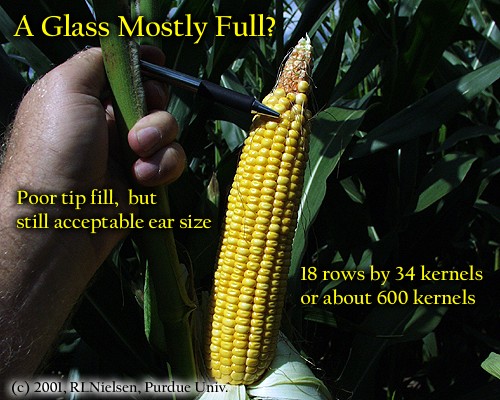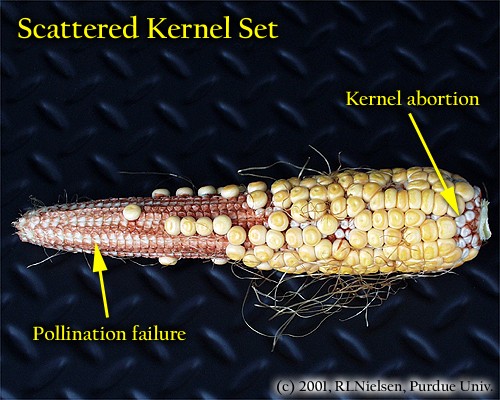![]() éjà vu or serendipity? Several weeks ago I
shared with readers the ins and outs of the corn pollination process (Tassel Emergence & Pollen Shed and
Silk Emergence) and the ways in which the
pollination process or subsequent grain filling period could go wrong (Yield Loss During Grain Fill). Since that
time, quite a few reports have come in describing pollination or grain filling
problems in fields around the state.
éjà vu or serendipity? Several weeks ago I
shared with readers the ins and outs of the corn pollination process (Tassel Emergence & Pollen Shed and
Silk Emergence) and the ways in which the
pollination process or subsequent grain filling period could go wrong (Yield Loss During Grain Fill). Since that
time, quite a few reports have come in describing pollination or grain filling
problems in fields around the state.
For the record, let’s remember that pollination failure in corn is caused by either lack of viable pollen, failure of silks to emerge or non-receptive silks. Kernel abortion is most likely to occur early in the kernel development process when photosynthesis is restricted (cloudy days, leaf disease, hail damage, severe N deficiency) or when photosynthate availability to the kernels is limited (excessively warm nights, competition with older kernels).
There seems to be a perception that one or two hybrids are especially affected this year. This may not be correct; especially if folks are concentrating on walking fields of those hybrids and ignoring fields of other hybrids. Indeed, I have observed serious tip fill problems and severely scattered kernel set in more than one hybrid and from more than one seed company.
Many fields exhibit some degree of pollination failure or minor kernel abortion near the tip of the ears. Typically, one finds one to two inches of barren cob. The bad news is that the yield loss is about five bushels for every absent ‘ring’ of kernels around the cob. The good news is that ear length potential this year was often quite exceptional owing to the generally favorable growing conditions prior to flowering.
In such fields, ear length potential was so long that the tip silks likely emerged after pollen shed was complete. The number of successfully developing kernels in these affected fields is still ‘normal’ (from 30 to 35 kernels per row), even though one or two inches of the ear tip are barren. So, count your kernels before you get all bent out of shape with the poor tip fill in your fields.

In some fields, the poor tip fill includes some number of aborted kernels in addition to simply blank portions of cob. Kernel abortion can be caused by any number of stresses, including excessively warm nights (low to mid-70’s) during silking or severe moisture deficits. Some areas experienced several days of heavy overcast clouds during or shortly after the pollination process. Such excessive shading or lack of intense sunlight soon after fertilization of the ovary occurs can easily abort kernels. Instances of all three climatic conditions occurred in areas throughout the state during pollination. The cause of the abortion revolves around a limited photosynthate supply to the younger developing kernels.
Unfortunately, the tip fill problems in other fields are not related to exceptionally long ears or simply to warm nights or limited photosynthate supply. Harvestable kernels per row of ears in some fields sometimes number only 15 to 20. Moreover, varying degrees and frequencies of severely scattered kernel set also exist in many fields.
 >
>In the fields I’ve walked, the more severe kernel set problems are usually associated with significant levels of clipped silks. In most cases, it is unclear whether corn rootworm (CRW) or Japanese beetles were the culprits, although goose-necked plants in many of these fields were a good indication that serious CRW larvae feeding injury to roots was a problem earlier in the season.
The kernel set problems seem to be most prevalent in fields where uneven plant development occurred due to uneven emergence or uneven seedling growth. In the fields I’ve walked, severe silk clipping and resulting kernel set problems were most evident in delayed plants than in ‘normally’ developing plants. Normal and delayed plants side-by-side typically exhibit ears that are night and day different in the success of pollination. Plants in fields with more uniform plant development exhibit less silk clipping in general and fewer problems with severe scattered kernel set.
Uneven stands or plant development can be attributed to a) uneven seedling emergence, b) injury from the Mother’s Day frost event, c) uneven plant development catalyzed by late May/early June cold snap, d) injury from postemergence herbicide applications, e) chilling injury from the mid-June cold snap, f) chilling injury from the early July cold snap, or g) injury from CRW larvae root feeding. Any combination of the above stresses could have set back plant development unevenly throughout a field. The delayed plants would silk later and be more attractive to CRW or Japanese beetles than would ‘normal’ plants.
The severe tip fill problems or scattered kernel set associated with insect silk clipping are interesting because few people, including yours truly, thought it was much of an issue back in early July when fields were pollinating. Maybe we were simply avoiding corn fields during the heat and humidity and did not notice the problem.
There are also indications that earlier planted fields and earlier maturity hybrids are less affected than later planted fields or later maturity hybrids. My own planting date study at the Purdue Agronomy Farm illustrates the worst-case scenario for CRW/Japanese beetle silk clipping in late-planted corn. Over many years of conducting planting date studies, I have never seen such extensive CRW beetle feeding on the silks in later-planted corn.
There are also a couple of weather-related issues that may have played a role in setting up the corn plant for pollination failure. Above normal temperatures experienced in some areas during pollen shed could have caused faster pollen shed completion at the expense of later silk emergence from tip ovules of long ears or delayed silk emergence due to excessive CRW/Japanese beetle silk damage.
An admittedly farther stretch of imagination suggests that it is possible that the one or two cold nights in early July (remember the frost injury in low-lying muck fields) interfered with normal pollen maturation, resulting in less total pollen or some frequency of unviable or defective pollen. Similarly, the late May/early June cold snap may have interfered with initiation of tassel branches and spikelets due to the timing of the chilling injury with the initiation of tassels occurring in corn that was at growth stages V5-V6. Interference with either tassel development or pollen maturation would have left the corn plant more vulnerable to the effects of severe silk clipping by insects.
Related Research References:
Bechoux, N., G. Bernier, and P. Lejeune. 2000. Environmental effects on the early stages of tassel morphogenesis in maize (Zea mays L.). Plant, Cell & Environment. 23(1):91-98.
Cantarero, M.G., A.G. Cirilo, and F.H. Andrade. 1999. Night temperature at silking affects kernel set in maize. Crop Sci. 39(3): 703-710.
Reed, A.J., G.W. Singletary, J.R. Schussler, D.R. Williamson and A.L. Christy. 1988. Shading effects on dry matter and nitrogen partitioning, kernel number, and yield of maize. Crop Sci. 28(5): 819-825.
 For other
information about corn, take a look at the Corn Growers Guidebook on the World
Wide Web at http://www.kingcorn.org
For other
information about corn, take a look at the Corn Growers Guidebook on the World
Wide Web at http://www.kingcorn.org